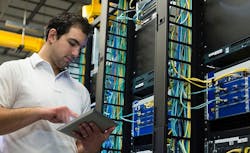The Promise of 5G: Accelerating IoT and Artificial Intelligence at the Edge of the Network
Martin Olsen, Vice President, Global Edge and Integrated Solutions at Vertiv, outlines how 5G and edge computing is contributing to IoT and AI advancement.
Martin Olsen, vice president, global edge and integrated solutions,Vertiv
If you’re one of the 90 million people around the world who use Waze, you probably take it for granted that the voice of Morgan Freeman or Mr. T might help you avoid a traffic jam, a speeding ticket or a repair bill with a helpful, “pothole ahead” or similar warning. But if you stop to think about it, that crowd-sourced navigation app is a marvel of modern technology. Consider: The app collects and analyzes massive volumes of data from users and pushes useful information to other drivers in real time. Waze and its brethren are the real-world embodiment of every significant technology trend of our age – the Internet of Things (IoT), the edge of the network, machine learning, artificial intelligence (AI) and, soon enough, 5G.
Of course, Waze is just the beginning. Self-driving vehicle pilots are taking place in 19 cities, with infrastructure expanding daily to enable future deployments. Estimates suggest that in 2025, about 8 million vehicles will be shipped with some level of autonomous self-driving capabilities, and that introduces complexity an order of magnitude greater than Waze and other navigation systems.
Smart irrigation controllers can detect water leaks and help reduce water consumption in drought-stricken environments.
The infrastructure challenges associated with an autonomous future are substantial, however. An average 25-minute drive to work requires constant data transmission and analysis and real-time adjustments, and that means sophisticated computing not just in the vehicles, but along every roadside, everywhere those autonomous vehicles will travel. Autonomous cars will generate about two terabytes (2,000 gigabytes) of data just on that 25-minute drive to work. To put this in perspective, the average U.S. consumer uses about 10 gigabytes of data per month and would take about 17 years to go through two terabytes.
Of course, navigation and autonomous vehicles are just two examples of the many interesting applications of AI, IoT and even virtual reality emerging around the globe. IT-enabled lampposts that double as data intelligence networks are improving transportation, traffic and personal safety in a variety of ways. Smart irrigation controllers can detect water leaks and help reduce water consumption in drought-stricken environments. Even the NBA has waded into technology revolution, broadcasting five games in virtual/mixed reality during the current season. It’s happening all around us.
Some areas are reacting to these advancements faster than others. In Australia, the cities of Adelaide and Canberra are among the global leaders in developing the critical network edge infrastructure needed to support next-generation citizen services and boost the economy. In the U.S., Verizon and Sprint have announced test cities, including Atlanta, Dallas, Miami, New York, Sacramento and Washington, DC, for 5G rollout, and 5G will enable and accelerate all of these innovative technologies.
A more robust, critical edge of the network, leveraging hybrid IT and integrated systems, is delivering compute resources as close as possible to the end user. This, in turn, is inspiring new business models and applications and supercharging the personal experience with the help of a new wave of even smarter mobile devices. At scale, that is translating to smart cities powered by millions of sensors deployed in every imaginable configuration to provide actionable data in real time. It’s the autonomous car writ large.
The IT systems needed to make it all a reality must be unwaveringly reliable, incredibly powerful, capable of low-latency transmission, and small enough to mount on light poles or be stored in omnipresent enclosures. That list presents a significant infrastructure challenge, requiring power protection, thermal management and, importantly, remote monitoring, management and service capabilities. This micro-edge will be networked not just with local resources, but with data centers and cloud facilities around the world.
Daunting? Sure, but also exhilarating. Like taking a trip with the virtual support of fellow Wazers, we may have different destinations, but we are traveling together. I look forward to the journey of a connected future with the boost of 5G.
For more information on these topics, check out our white paper that uses our edge archetypes to identify the most promising use cases for 5G.
Martin Olsen is Vice President, Global Edge and Integrated Solutions for Vertiv.


